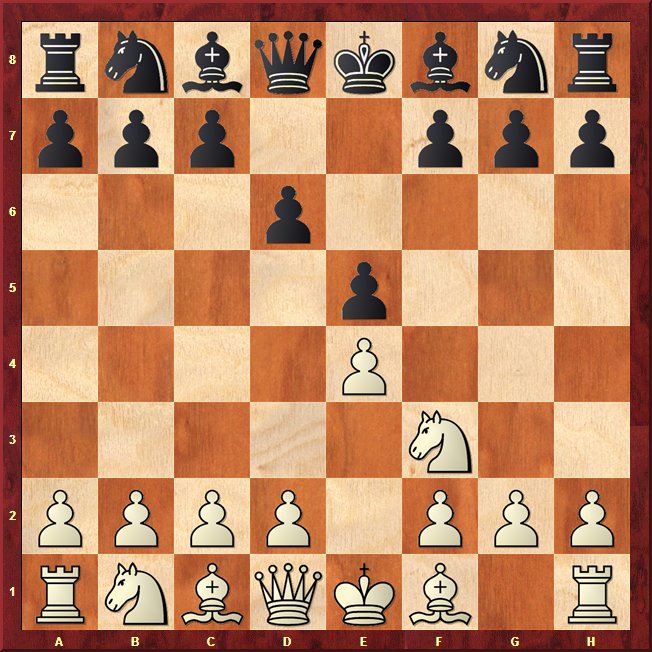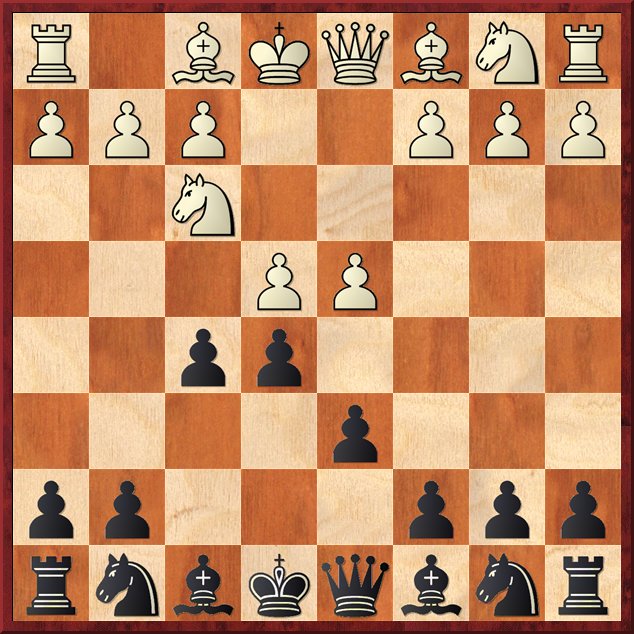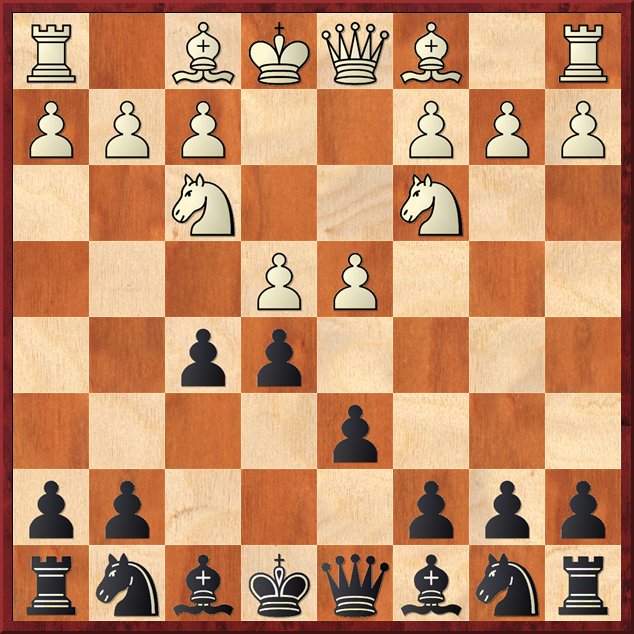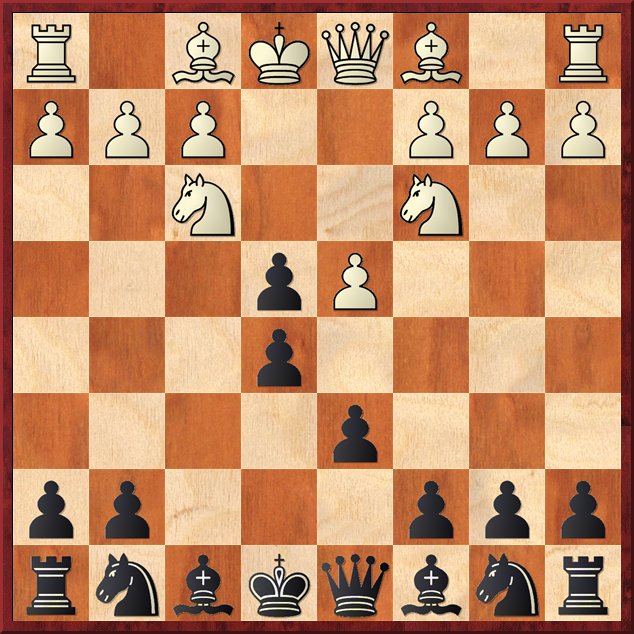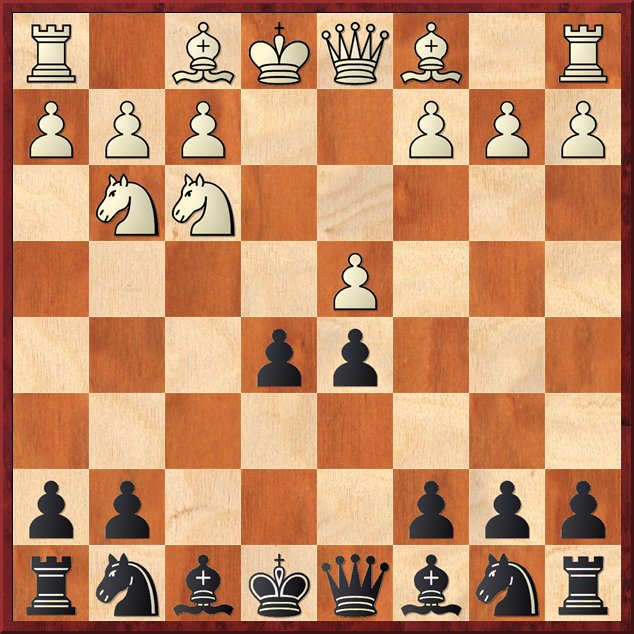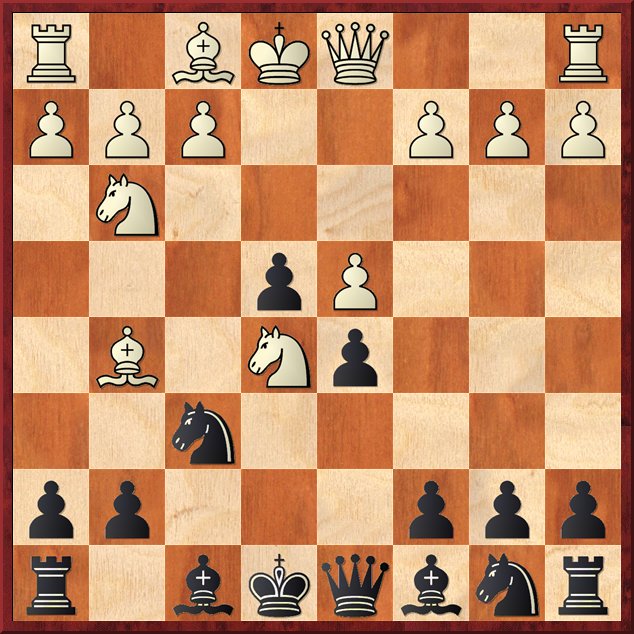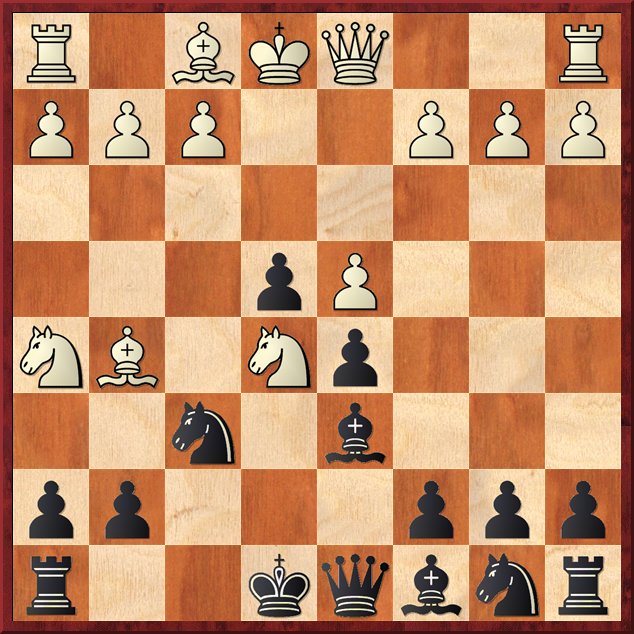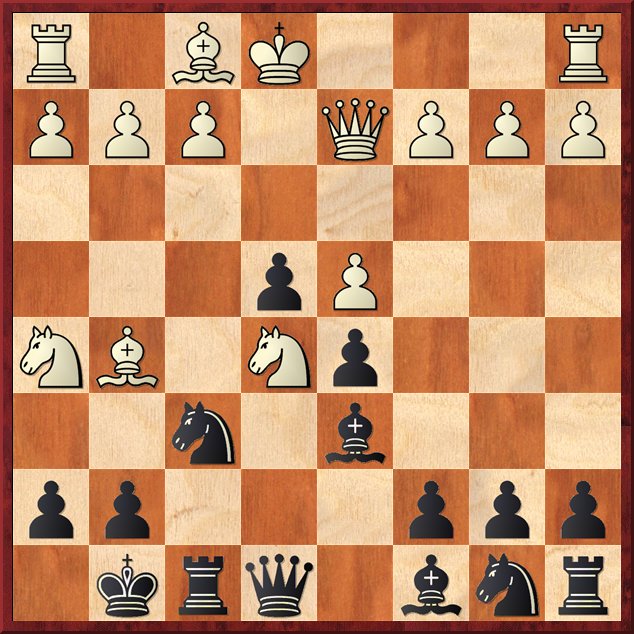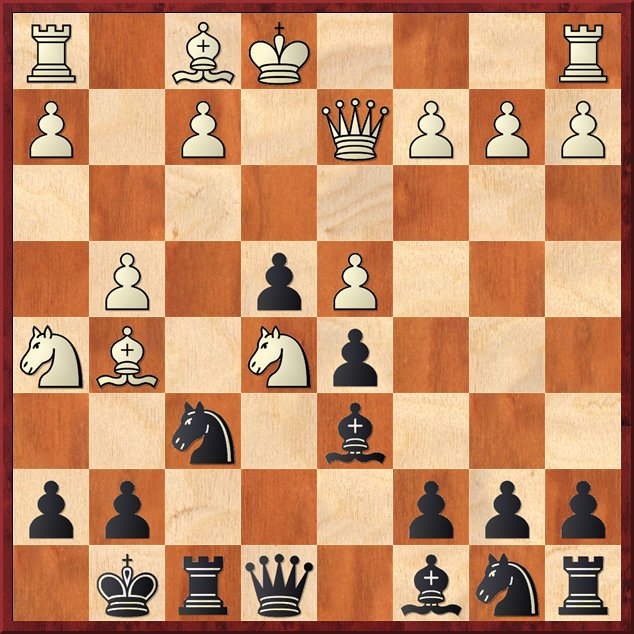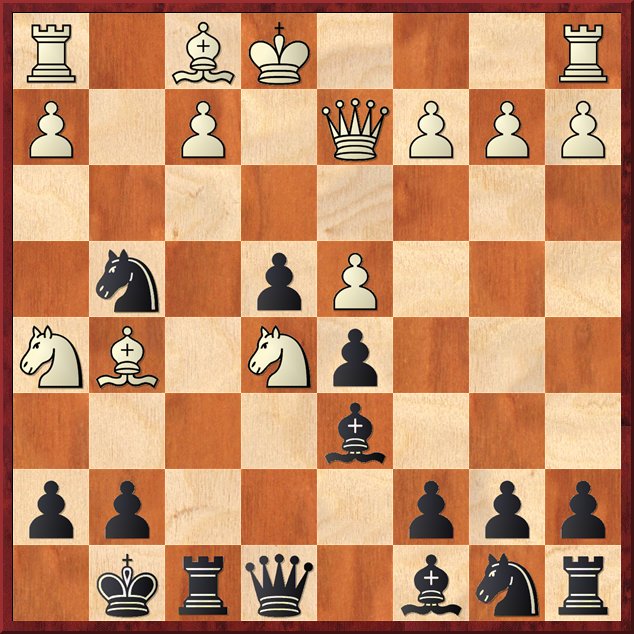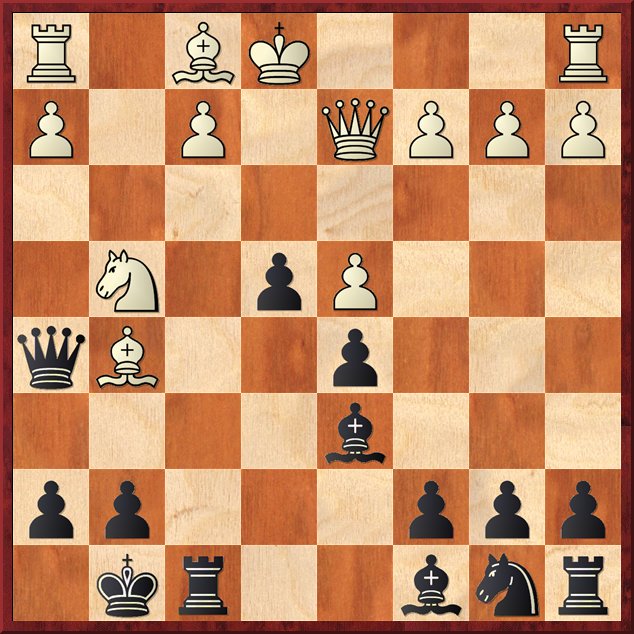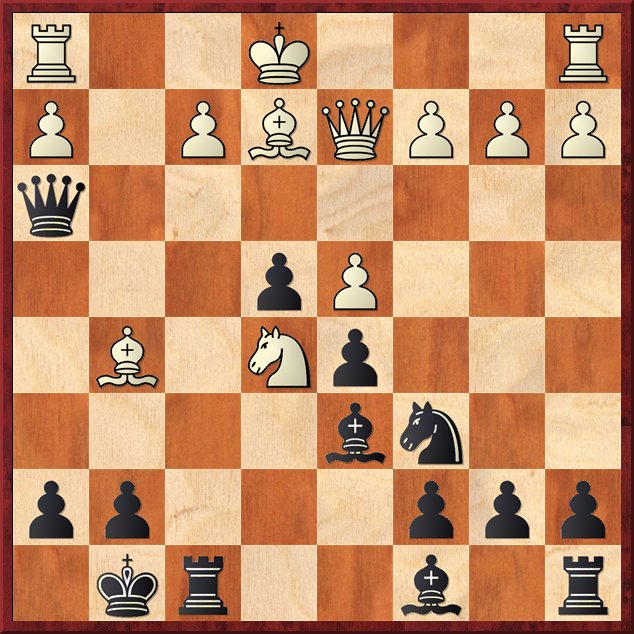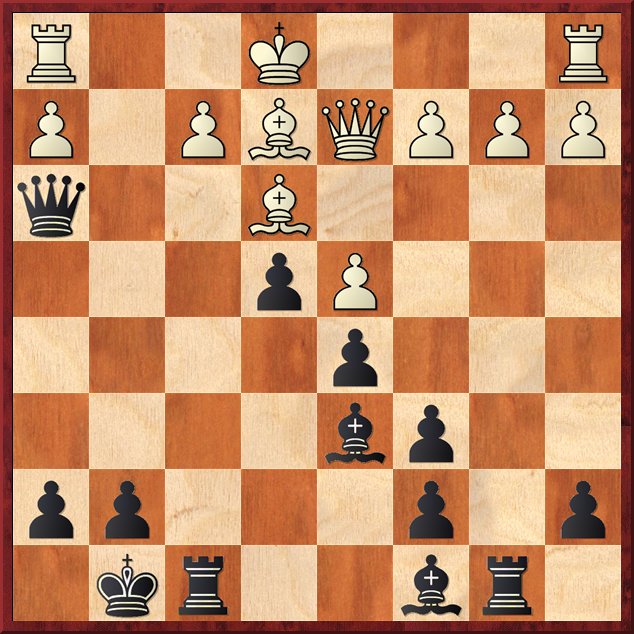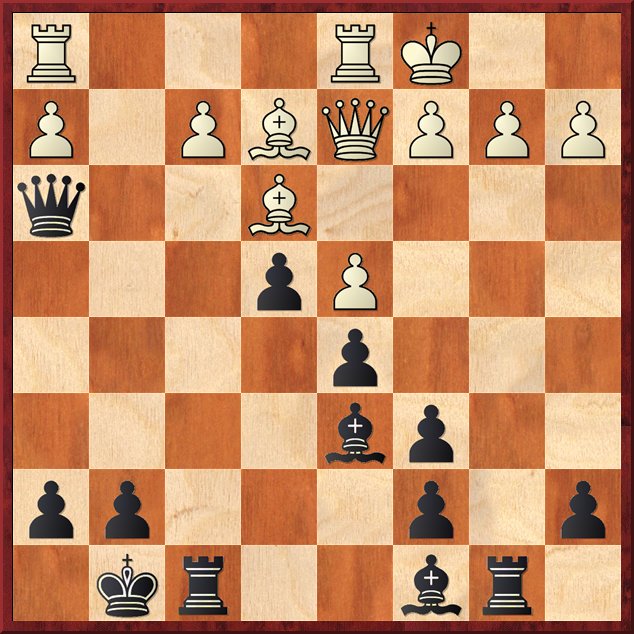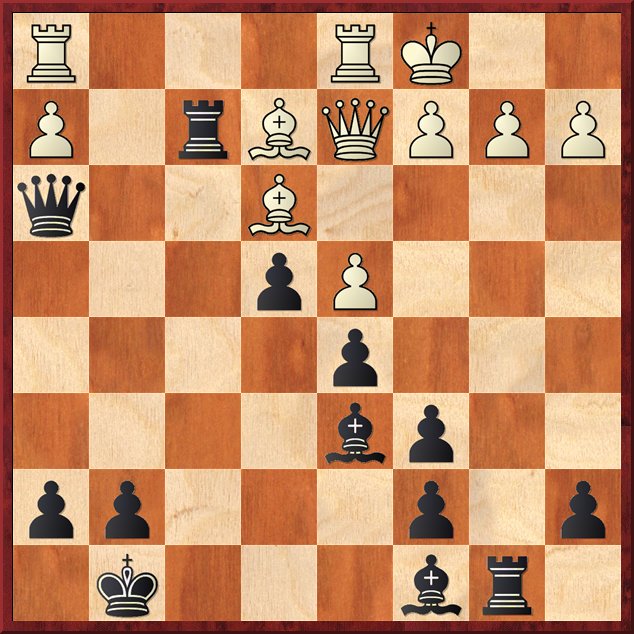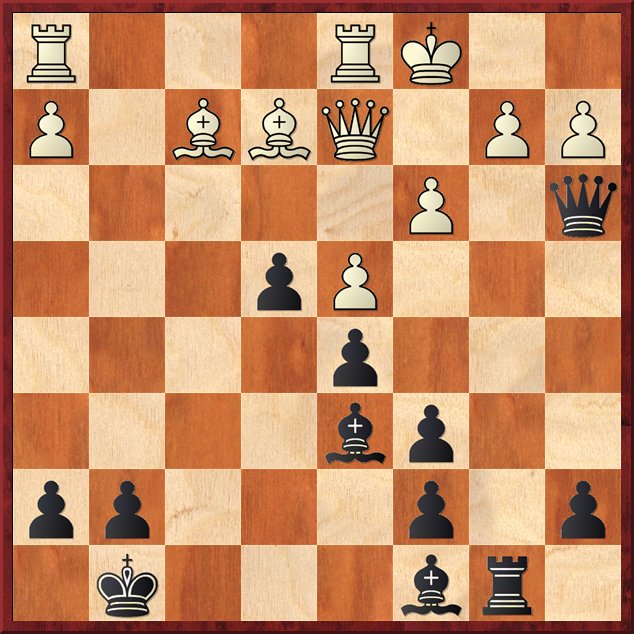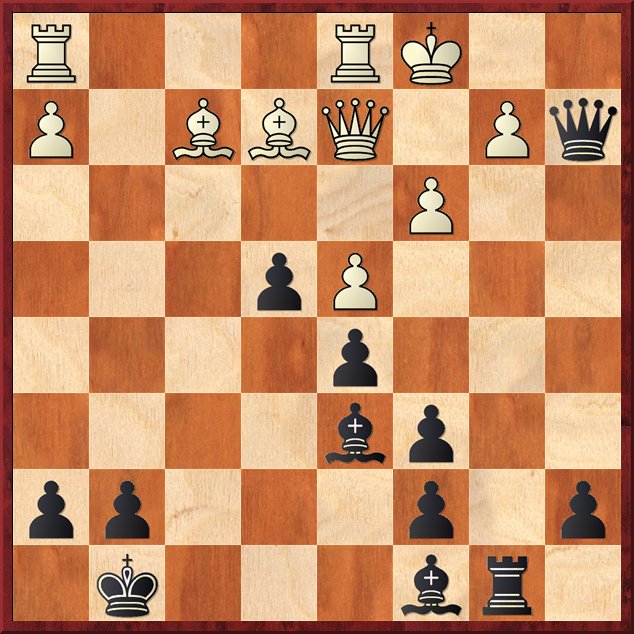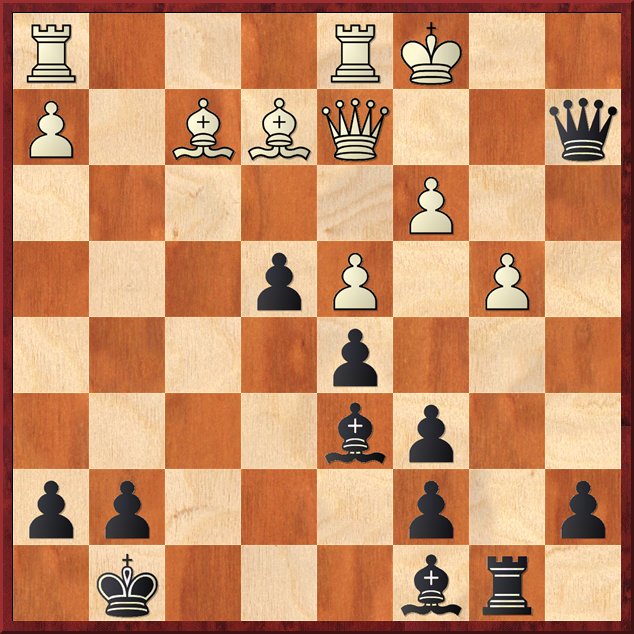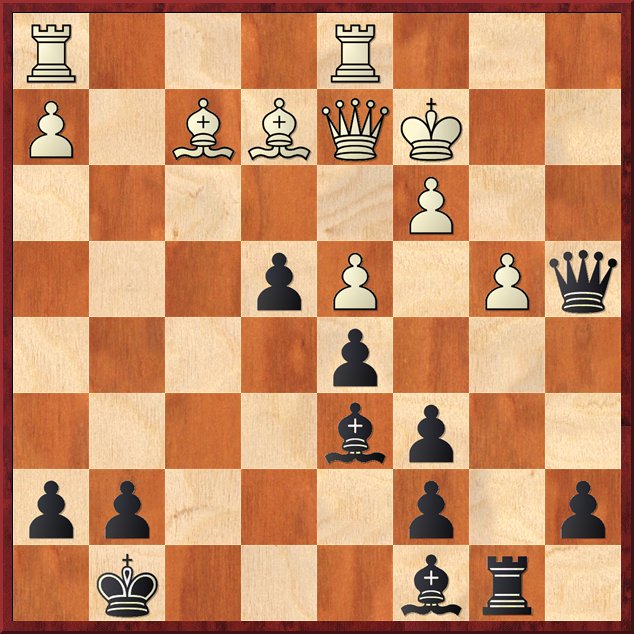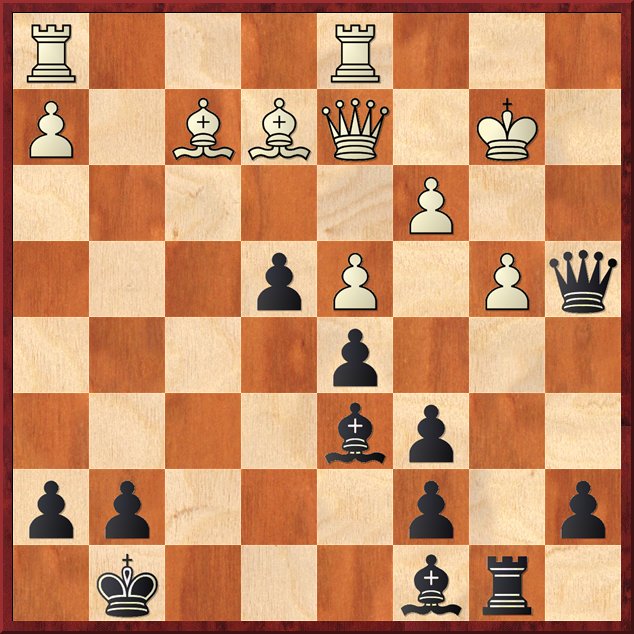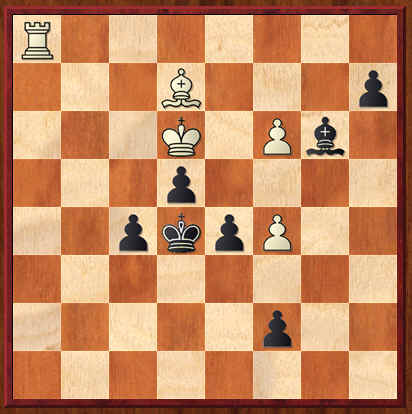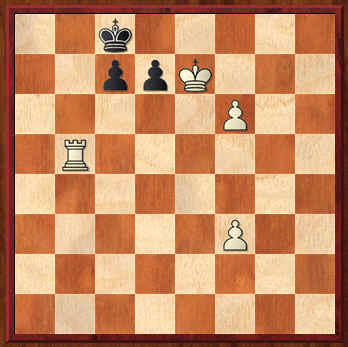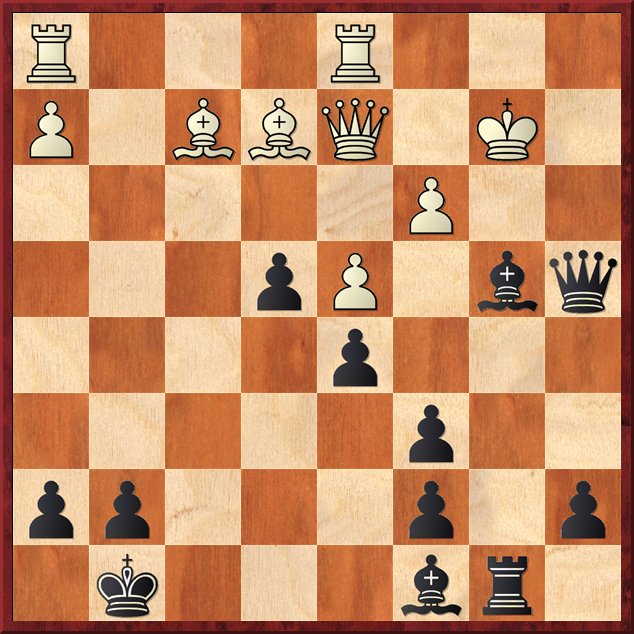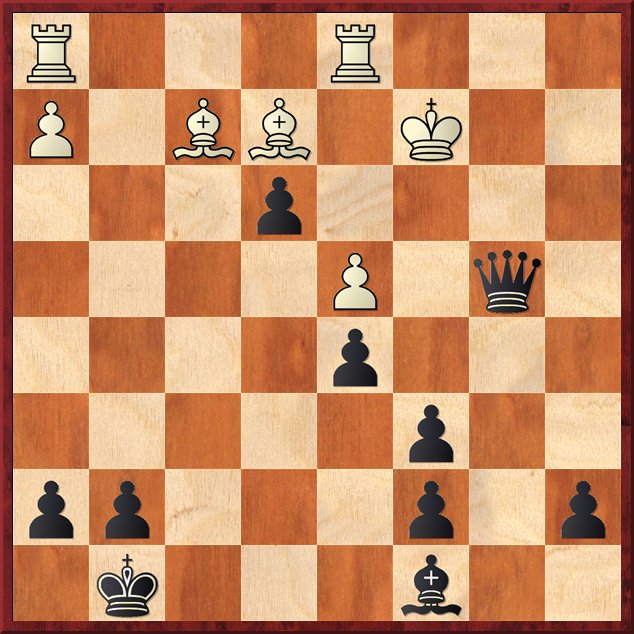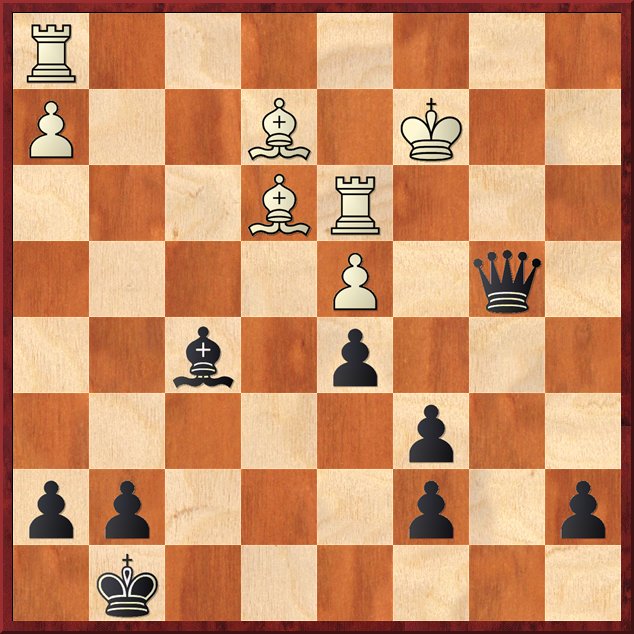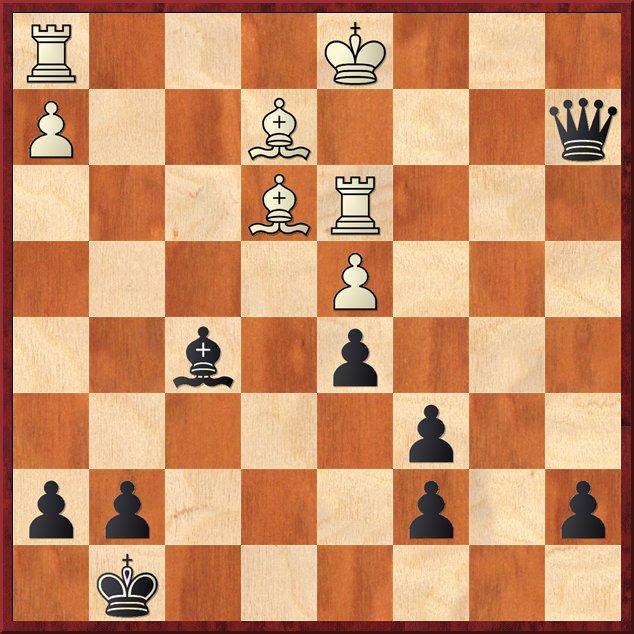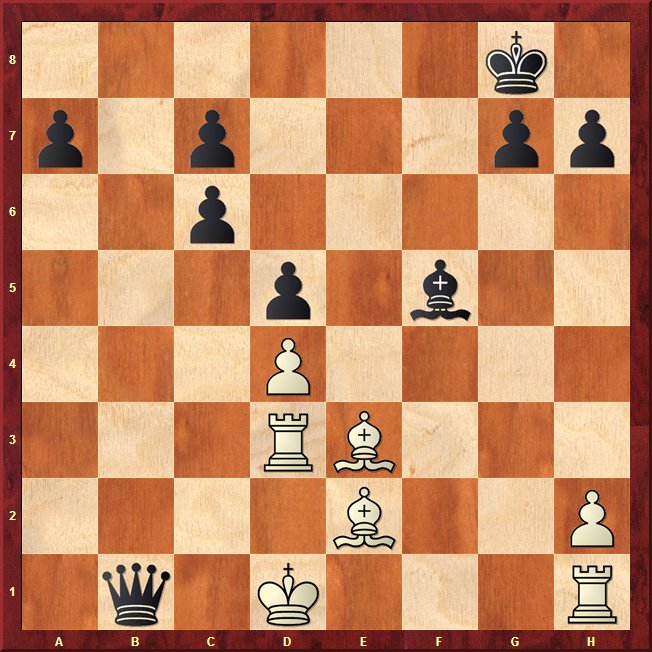All
the |
(Navigation bar
directly below.)
*******
© A.J. Goldsby, 2015.
(All rights reserved.)
****************
Click HERE
to see my
Chess Items.
****************
****************
Buy a book
from Amazon.com
(And help me out as well!)
****************
Click HERE
...
to see a list of the businesses that help to sponsor all of
my chess efforts.
|
|
|
Click HERE to see an explanation of the symbols that I commonly use when I annotate any chess game. Click HERE to replay this game. (Click HERE to see a "star-dot-pdf" / Adobe copy of my analysis.) Click HERE to see my video channel on the "You-Tube" channel. (Click HERE to see my YT video on this game.) |
|
This is a game that I have been studying for nearly as long as I have been playing chess. (I am currently 55 years old, I started playing chess when I was four.) This was one of the very first games that I ever saw that I can remember looking at in any chess book. (Probably the first real chess book that I ever studied was a book of Morphy's games.) I have spent countless hours - over the last 25-30 years - studying this game. To be honest - I have never tired of it, nor grown weary of its seemingly unending supply of new and interesting moves. I have done so many DPA's (deep position analysis) over the years, that I have lost count. I also have spent maybe a few hundred hours working on this game over the years, and with the chess engines, this has been a lot of time exploring the intricate variations that this fantastic game of chess contains. I hope you enjoy it half as much as I have. (And that's a lot!!)
Henry Edward Bird
(2462) - Paul
Morphy (2650)
|
|
|
[A.J. Goldsby I]
(I first began working on this version of this game in <around> 2001 - although I quickly dropped it, and did not pick it up again until almost three years later. The bulk of the annotations here were written in (around) 2004 ... ... ... {except where otherwise noted}.)
(I also had an earlier version of this web page ... on an older site that has apparently been deleted or erased. When I first learned of this matter. I was extremely upset. But - now, in a way - I am glad that it happened. Many of these pages were MUCH older analysis, and really needed to be updated. {Many of the links were broken - great changes over time.} Additionally, when I first did the analysis of these games, engines were MUCH weaker ... or - in some cases - I even began working on many of Morphy's games long before chess engines were created. Anyway, having said all that, let me just say that this newer analysis has been thoroughly completed and checked with all of the latest engines ... Fritz 13, Houdini, Deep Shredder, Rybka, etc. - A.J. Goldsby I, Oct. 2nd, 2013.)
*************************************************************************************************************************************************
One of the more famous games that Paul Morphy ever played, it is also another superlative example of his incredible chess prowess.
I had received countless requests to annotate this game, but prior to now, I never had a really good reason to do so. (Several authors had previously done "The DEFINITIVE Analysis" of this historic chess encounter ... so I saw no real reason to try my hand at it. Actually - I began to {half-heartedly} analyze this game about a dozen different times - but I always got sidetracked by various other projects.)
<<
A little over a year ago, (the summer
of 2004); someone sent me a truly historic e-mail. It contained a link to a Russian site which analyzed several
old games of chess, this was the second game that it looked at. (The first was a
game of the McDonnell-La Bourdonnais match.) >>
(I went looking for
this link when I was formatting this game for publication on my website.
However, today, I cannot find the original link, although many of other
links ...
like the ones for GM K. Mueller's analysis ... are still readily
available. - "Ye olde editor" A.J.G; September 28th,
2013.)
-
Click here to see a *.pdf copy of GM Karsten Mueller's analysis. (Excellent work, he pioneered much of the research into
the possibilities after 22.Kc1, a7-a5!! Mueller and Knaak were also the authors of the excellent CB CD/DVD on Morphy.) -
Click here. [This game is on the CG website, the comments/kibitz <section> (just below the game) contain MANY links and
also some very good analysis. Some of the analysis - not by me, but by "Patzer2," "RandomVisitor" ... and also many others -
are very good, were generated with strong engines, and meticulously checked. I have posted some of my analysis there, as well.]
<<
Although my ability to read Russian is
limited to one or two words, it was obvious from the exclams and double-exclams what the authors thought of
this game. This began over a year of research and analysis into this epic chess struggle, which culminated
in the work that you are reading now. >>
{I left this paragraph intact, although I initially wrote it in 2005, in 2011 ...
it looks a little bit odd. However, I had anticipated finishing this game in a short amount of time,
although events in my life simply did not allow this to happen.}
This game is also wonderfully analyzed
by GM Larry Christiansen. [(On the
"ChessMaster, 10th Edition," program.)
{Go to} Main menu ---> Learn ---> Academy ---> Larry Christiansen's Attacking Chess.]
*** *** *** *** *** *** *** *** *** *** *** *** *** *** *** *** *** *** *** *** *** *** *** *** ***
This was a game played between Paul Morphy, and the English player, H. Bird. (The match was probably played for stakes, although these had to be negotiated through a 3rd party, as Morphy's family had set him the condition of not gambling prior to his departure from America.)
The ratings here are just estimates!!!
Mr.
Jeff Sonas does not give a rating for Paul Morphy in January, 1858; and
only gives Henry Bird as 2462.
But the records are terribly sketchy for this period of chess history, but it was
clear from several sources that Bird was considered to be one of the leading
masters of his whole era.
(In this day and age of
grossly inflated ratings, Morphy would easily be 2700 or even 2800+, while
Bird could easily be a 2500+ player. - editor)
1.e4 e5; 2.Nf3 d6;
The Philidor Defense. [more] [a few sample games]
|
|
rnbqkbnr/ppp2ppp/3p4/4p3/4P3/5N2/PPPP1PPP/RNBQKB1R w KQkq - 0 3
(NOTE: In the web page version of this game - since we are examining this game mainly from Black's perspective - all the diagrams are from the Black side.)
How Morphy arrived at this particular
opening, I will will never know.
(Some tendency that Morphy had observed in Bird's earlier games? Or was it that
he simply wanted to try a line that was currently in the vogue ...
at that time in chess history?)
I can only find about 8 examples of
Morphy playing this opening in the games database, so we know that this was
NOT his favorite opening!
(As Black - against the KP opening.)
The only GM - that I know of -
(in modern times ...) that liked to play this opening on any kind of regular basis was GM B. Larsen.
[He even wrote a pamphlet for Chess Digest, (Ken Smith, Dallas/TX); entitled:
"Why Not The
Philidor Defense?"]
3.d4 f5!?; (Daring? / Unsound?)
An extremely risky counter-attack (gambit) that was "all the rage" in the mid-1800's. Apparently, even Morphy was not immune to the 'fashions' of trendy chess openings. {See also Barnes-Morphy, 1858 ... If you have the ChessBase dB of games.}
Of course, in those days, opening knowledge rarely went past move five, and generally did not extend past move ten, so it would have been very difficult - at that the time that this game was actually played - to accurately judge the overall soundness of this move.
|
|
rnbqkbnr/ppp3pp/3p4/4pp2/3PP3/5N2/PPP2PPP/RNBQKB1R w KQkq f6 0 4
Today, with millions of games played,
{Refers mainly to the biggest DB's.}; we know that 3...f5;
is highly dubious,
I doubt there is a single example of a GM using this move in modern chess praxis. ('?!' - GM Garry Kasparov.)
{None-the-less,
(and despite what I wrote, just above) we
find the game
Charbonneau-Nakamura
(2010) in the
ChessBase
database ... Black loses badly, see the box just below - for the entire game
score.}
[Event "Lloydminster BATB op 4th"]
[Site "Lloydminster"]
[Date "2010.09.05"]
[Round "4"]
[White "Charbonneau, Pascal"]
[Black "Nakamura, Hikaru"]
[Result "1-0"]
[ECO "C41"]
[WhiteElo "2513"]
[BlackElo "2733"]
[PlyCount "61"]
[EventDate "2010.09.04"]
[EventType "swiss"]
[EventRounds "6"]
[EventCountry "CAN"]
[Source "ChessBase"]
[SourceDate "2010.10.29"]
1. e4 e5; 2. Nf3 d6; 3. d4 f5; 4. exf5 e4; 5. Ng5 Bxf5; 6. f3 exf3; 7. Qxf3 Qe7+;
8. Kd1 Qf6; 9. Qxb7 Qxd4+; 10. Bd3 Qg4+;
11. Nf3 Bxd3; 12. cxd3 Ne7; 13. Qxa8 Nec6; 14. Qb7 Be7; 15. Rg1 O-O; 16. Be3 Kh8; 17. Nbd2 d5; 18. Rc1 Qg6; 19. d4 Bb4;
20. Ne5 Nxe5; 21. Qxb4 Qg4+; 22. Nf3 Nbd7; 23. h3 Qe4; 24. Nxe5 c5; 25. Qd2 cxd4; 26. Qxd4 Nxe5; 27. Qxe4 dxe4;
28. Ke2 h6; 29. Rc7 Nd3; 30. Rf1 Rg8; 31. Bd4, 1-0
[replay]
[ A better (sounder) way to play would have been:
>/= 3...Nf6; 4.Nc3 Nbd7;
5.Bc4 Be7; 6.0-0 0-0;
7.Re1 c6; 8.a4, +/= (space)
White has a very solid edge, Black's results from this position - at the highest levels -
have not been very encouraging.
See the GM contest: A. Shirov - Z. Azmaiprashvili; The
(FIDE) Men's Olympiad
(tt=team
tourn.)
Calvia / Mallorca, ESP; 2004. {White won a very instructive game, 1-0, in just 43 overall moves.}
[ See (also) MCO-14, beginning on page 128 / columns # 01 - # 06 / for more info on these lines. ]
[ See also MCO-15, the coverage of
the Philidor's Defense begins with page # 132.
(Col.'s # 01 - 06; and all the notes that apply.) ]
******************************************************************************************************
GM Bent Larsen advised Black to capture on d4 here:
(>/=) 3...exd4!?; {Diagram?}
This surrenders the center, but avoids many of the severely cramped positions that are often so typical
of the Philidor Defense.
4.Nxd4 Nf6; 5.Nc3 Be7;
6.Be2 0-0; 7.0-0 Re8; 8.f4!?,
"+/=" {Diagram?}
with a small (space) advantage for White.
For an example of play - with the continuation after 8.f4!? - see the
following game:
GM R. Felgaer - GM L. V. Nisipeanu;
Calvia (FIDE)
Men's Olympiad
/ Mallorca, ESP; 2004. (1-0, 73 moves.) ]
4.Nc3, (Too routine?)
White brings out both of his cavalry units, a move which follows opening principles.
|
|
rnbqkbnr/ppp3pp/3p4/4pp2/3PP3/2N2N2/PPP2PPP/R1BQKB1R b KQkq - 0 4
The move does develop a piece, but for whatever reason, modern masters consider this try to be somewhat innocuous here.
[ Possibly two superior alternatives here for White were:
(>/=) 4.dxe5 fxe4;
5.Ng5 d5; 6.e6, "+/=" - GM Larry
Christiansen.
********************************************************************************
Or even: (>/=) 4.Bc4
exd4!?; 5.Ng5 Nh6; 6.0-0,
"+/=" (Probably even - '±')
with good chances for White. (also - GM Larry
Christiansen)
********************************************************************************
Another good line would be: (>/=)
RR
4.exf5! e4; 5.Ng5 Bxf5; 6.Nc3
d5;
7.f3, '±' (w/advantage) - GM Bent Larsen.
White has a very large edge, some engines already evaluate this position as
winning for the first party, here.
[ See MCO-15, page # col. # 01; and especially note # (a.) here.] ]
4...fxe4; ["!?" (hmmm)]
Black captures on e4 - this opens the game, temporarily gains a Pawn, and perhaps hopes to win a tempo (or two) because of the attack on the White Knight.
|
|
rnbqkbnr/ppp3pp/3p4/4p3/3Pp3/2N2N2/PPP2PPP/R1BQKB1R w KQkq - 0 5
Some masters {notably Steinitz} have condemned this move as too risky. ['?'] (Black opens even more lines.)
However, the move looks perfectly natural to me, and is also the first choice of several strong computer programs as well. Further, after the third move, Black cannot really avoid getting a disadvantage ... no matter what line he plays here.
[ Some masters have said that Black should play instead the capture on d4,
however White gets a solid edge against that try as well.
For example: (>/=) 4...exd4!?;
5.Qxd4!? Nc6; 6.Bb5, "+/="
(Maybe - '±')
when White is clearly better.
- GM Larry Christiansen ]
(A possible improvement - over the course of the actual game - might have been 5...Nf6; this is the line that most of the engines prefer.)
5.Nxe4 d5; 6.Ng3, (Too passive?)
A calm move ... backing away from the complications. (In Bird's defense, he thought for quite some time before playing this move. The complications
are truly mind-boggling, maybe he never saw a line he truly considered to be completely winning for him, 6.Neg5 might have been better than game, as well.)
|
|
rnbqkbnr/ppp3pp/8/3pp3/3P4/5NN1/PPP2PPP/R1BQKB1R b KQkq - 0 6
This move has been virulently, universally and totally condemned by dozens of modern masters, (I.e., Ng3?); who state (quite confidently) that White should 'sac' a piece here ... but the pundits have NEVER proven a win (for the first player) beyond any shadow of all doubt.
I think that the two severest critics of this move were Staunton and Steinitz.
(Neither were capable of really being totally objective when it came to Mr. Paul Morphy ... or his chess games.)
[ Once again, I refer you to the former U.S. Champion's analysis:
6.Nxe5! dxe4[]; 7.Qh5+ g6[];
8.Nxg6! hxg6!; {Diagram?}
Calling White's bluff.
(Worth a look was: </= 8...Nf6!?; 9.Qe5+ Kf7;
10.Nxh8+ Kg7;
11.Bg5 Be7; 12.0-0-0 Kxh8;
"<=>"
and while Black has some play and some "comp" here, White
looks to be solidly better in this position. ('±')
A Rook + 2P's for two N's.)
9.Qxg6+! Kd7;
10.Qf5+ Ke8; 11.Qe5+ Be6!; 12.Qxh8 Qd5!?;
"<=>" ("comp")
when the respected GM thinks that Black might be OK.
- GM Larry Christiansen | See the program/disk;
"ChessMaster, 10th Edition.")
(Or 12...Nc6; 13.Be3 Nf6; 14.0-0-0 Kf7; 15.Be2 Bg7; 16.Qh4, '±' - Fritz 12. ) ]
6...e4; 7.Ne5 Nf6; {Equal?}
Now Black seems to have no real problems in this position.
(White may have a small edge here, but it isn't anything to get really excited about.)
8.Bg5!?, (Double - hmmmm!)
Some consider this to be dubious, one GM called it, "a perfectly normal developing move in this position."
|
|
rnbqkb1r/ppp3pp/5n2/3pN1B1/3Pp3/6N1/PPP2PPP/R2QKB1R b KQkq - 0 8
While this pin is not a gross violation of opening principles, I do agree with those analysts who feel that White should have immediately taken steps to try and break down Black's imposing central Pawn phalanx.
[ A big improvement over the course of the game was:
>/= 8.f3! exf3;
9.Qxf3, "+/="
the analysis engine - Fritz 12. (The machine considers that White is solidly better
in this particular position.)
************************************************************************************
Or 8.Be2 Bd6; 9.c4, "+/=" when White might have a very small edge. ]
8...Bd6; 9.Nh5?!, (Maybe - '?')
This looks to be a normal exploitation of a pin, but today we know that it is a a bad idea to move the same piece more than once in the opening ...
unless you can prove an advantage, beyond any shadow of a doubt.
|
|
rnbqk2r/ppp3pp/3b1n2/3pN1BN/3Pp3/8/PPP2PPP/R2QKB1R b KQkq - 0 9
Probably f3 or c4 ("+/=") were better than this particular move. (Or even Be2 with the idea of castling next.)
[ One former student of mine suggested the (following) try of P-QR3, which is not all that bad.
9.a3!? 0-0; 10.c4! Nc6!?; 11.Nxc6 bxc6;
12.c5 Be7; 13.Be2, "~"
(Unclear, possibly equal?)
with a fair position for both sides. ]
(In the following line, 10.BxN/f6; may have been an improvement over the course of the actual game.)
9...0-0; 10.Qd2!? Qe8!;
Bird probably overlooked this sly move by the great Paul Morphy.
|
|
rnb1qrk1/ppp3pp/3b1n2/3pN1BN/3Pp3/8/PPPQ1PPP/R3KB1R w KQ - 0 11
This is a good position to stop and take a look around. And after only ten moves, White's situation is already close to being critical.
11.g4?, (Gag! Ugh! Barf!)
A truly horrible move, inflicting a gash in White's King-side and it is also a play which immediately confers a very large advantage to the second player.
|
|
rnb1qrk1/ppp3pp/3b1n2/3pN1BN/3Pp1P1/8/PPPQ1P1P/R3KB1R b KQ g3 0 11
This move is motivated by a very cheap tactic, which Morphy manages to side-step without any difficulty.
(After years of studying Bird's style, I can say {now} that Bird would often find strange and even bizarre tactical shots ... and eventually make them work. Here, the anti-positional g2-g4 would only work if White had a lot more development than he does here. White does gain an open g-file to the Black King, which could have proven dangerous to Morphy, if the situation was just a little different than it was here. - A.J.G; 2013.)
[ A player who once was rated as #1 in the world, (GM Geza Maroczy); gave the following continuation:
11.Nxf6+!? gxf6; 12.Bxf6 Rxf6?!;
An inferior move ... missing a fairly obvious tactic.
(Much better was: >/= 12...e3!; "/+" with a solid edge for Black.)
13.Qg5+ Rg6; 14.Nxg6 hxg6;
15.Qxd5+, "~"
(Unclear. Too crazy!)
when the play becomes (a little) vague.
****************************************************************************
Perhaps White's best chance was the following line:
>/= 11.Bxf6!
Qxh5; 12.Be2
Qf5;
(RR 12...Qe8!?; "=/+" - Houdini 1.5)
13.Bh4 Bxe5; 14.dxe5 Be6; 15.0-0 Qxe5; "=/+" - Fritz 12.
****************************************************************************
White gets into serious trouble with the greedy line of:
</= 11.Nxg7?
Kxg7; 12.Bh6+
Kh8; 13.Bb5!?
Nbd7!; 14.Bxf8
Qxf8;
15.Bxd7 Bxd7;
16.Nxd7 Nxd7;
17.0-0 Qf5; "/+"
(Black's much better.)
when Fritz 12 considers Black's game to be practically winning here.
[And here - I would have to concur with this assessment - White's Rooks will
not see action for several moves, while (in one more move) all of Black's
pieces can be poised for a killing blow.] ]
11...Nxg4; (Maybe - '!')
Morphy side-steps his opponent's carefully laid plans here ...
|
|
rnb1qrk1/ppp3pp/3b4/3pN1BN/3Pp1n1/8/PPPQ1P1P/R3KB1R w KQ - 0 12
Morphy did not fall for traps, at least not the large majority of the time.
[ Bird's concept is validated by
the following continuation:
</= 11...Bxg4?;
12.Nxf6+ gxf6;
13.Nxg4, '±'
(White is solidly better.)
when White is clearly on top.
***** ***** ***** ***** ***** ***** ***** ***** ***** ***** ***** ***** ***** ***** *****
The machine prefers: RR
11...Bxe5;
(Maybe - '!')
when things get really weird.
For now, I simply follow the moves of the engine here, as they proceed
to go off the "deep end" as far as the resulting complications go ...
12.dxe5, (Maybe - '!')
This looks the best to me, although it is far from clear, and it certainly is
not White's only option at this point.
( White could also play: 12.Nxg7!? Kxg7;
13.dxe5 Nxg4; "-/+"
(Analysis line - Fritz 12.)
when White is down a piece, and seems to lack the modern
factors that would indicate
12...Nxg4; 13.Qxd5+
Be6; 14.Nxg7
Kxg7; 15.Bf6+!?,
Sacking a Pawn to open more lines to the Black King.
( RR 15.Qxe4 Qg6; "-+" - Houdini )
15...Nxf6; 16.exf6+
Rxf6; 17.Rg1+
Rg6; 18.Qe5+
Kf7; 19.Rxg6
hxg6;
20.Qxc7+
Qe7; 21.Qxe7+
Kxe7; 22.Bg2
Nd7; 23.Bxe4
Nc5!;
A nice trap, if White takes the tidbit on g6, than simply ...Rg8; will win for Black.
And - of course! - a piece down, White cannot possibly trade any more material.
24.Bh1!? a5!;
"-/+" - Fritz
13.
(- A.J. Goldsby;
Sometime in 2013, probably during the summer months.)
when the box has Black winning here by more than 3 points ... ... ... ]
12.Nxg4 Qxh5; {Lady - out!}
Morphy plays the "obvious" move, although "Bishop-takes-g4" was worth serious consideration here.
|
|
rnb2rk1/ppp3pp/3b4/3p2Bq/3Pp1N1/8/PPPQ1P1P/R3KB1R w KQ - 0 13
Black, with his pawn wedge in the center, his freer development and better pawn structure ...
looks to have already outplayed his opponent in this situation.
[ The other option here was: 12...Bxg4; 13.Nxg7 Kxg7!?; "/+" (Black is clearly better.)
(RR 13...Qg6; 14.Rg1 Bf3; "-/+")
14.Rg1,
"<=>" (With "comp." here.)
with some play down the file.
{This note dates back to 2001, in 2011, the box sees a clear edge for Black.}
]
In addition to what was played in the actual game, RR
13...c5;
was
also worth serious consideration for Black.
(Fritz 13 & Deep Shredder.)
13.Ne5[] Nc6!; 14.Be2 Qh3;
Morphy places his most powerful unit on the very edge of the chess wilderness ...
|
|
r1b2rk1/ppp3pp/2nb4/3pN1B1/3Pp3/7q/PPPQBP1P/R3K2R w KQ - 0 15
A hallmark of Morphy's play was that he rarely retreated.
[ Interesting was: 14...Qe8!?; {D?} with a good position for Black. ]
The next few moves require very little explanation ... Morphy continues to try and menace Bird at every turn.
15.Nxc6 bxc6; 16.Be3 Rb8;
A good - and obvious - move, placing a Black Rook on the half-open b-file here.
|
|
1rb2rk1/p1p3pp/2pb4/3p4/3Pp3/4B2q/PPPQBP1P/R3K2R w KQ - 0 17
The idea of 16...a7-a5; (to be followed by pushing the pawn to a4) is liked by several strong chess engines here. (Fritz 13, Houdini, etc.)
17.0-0-0!?, (Hmmm.)
White "castles into it," but (by now), I am not sure that he really had a clearly superior alternative.
(Most engines seem to indicate that White should castle Q-side.)
|
|
1rb2rk1/p1p3pp/2pb4/3p4/3Pp3/4B2q/PPPQBP1P/2KR3R b - - 0 17
Please study this position carefully.
[ RR 17.c3!? a5; 18.0-0-0 a4; "-/+" ]
Morphy's next move may be one of the most brilliant sacrifices ever made. Even in 2013, the engines do NOT seem to appreciate the depth or strength of Black's attack. Even the highest-rated programs do not play Morphy's move, no matter how much time you give them! It's also one of the deepest sacks ever made, the resultant positions seem to defy even engine-assisted analysis!!
17...Rxf2!!; [Really - '!!!' ... or even '!!!!']
Perhaps one of the most brilliant moves ever played ... even with database and computers, modern masters can not agree on the "correctness" of this move.
|
|
1rb3k1/p1p3pp/2pb4/3p4/3Pp3/4B2q/PPPQBr1P/2KR3R w - - 0 18
This one move has probably received every annotation symbol under the sun, the latest {Russian} analysis may show ...
that this move wins - BY FORCE - for Black!!!!!!!!!! ('?!' - GM Garry Kasparov.)
In my opinion, this is a true sacrifice, the complications that arise from this move truly are mind-boggling. It seems that we have only just begun to explore them once computer engines became strong enough not to be considered not just as toys, but as serious tools enabling deep analysis into the resultant positions. Credit is due also to GM Karsten Mueller; who undertook a whole series of articles that tried to investigate the correctness of this particular sacrifice.
[ GM Garry Kasparov
(and {first} GM Larry Christiansen) opined that the following move was better:
RR 17...Bg4!;
"/+" (Maybe "-/+") when Black has the better game ... and has an extra Pawn as well.
(Many chess engines - like Fritz 13 - also prefer this, as well.)
]
18.Bxf2 Qa3!!; (Ultra-glide!)
The stunning follow-up, now Black does threaten mates and mayhem ... yet it appears that Bird has a fairly simple answer.
[ Less effective (</=) was:
RR 18...Ba3!?;
19.Qe3!, "~" (unclear)
when Black may not have any advantage at all. ]
19.c3[], (This looks to be forced.)
This is virtually White's only good move here ... several masters give this an exclam ('!') ... but that looks like a bit of overkill to me.
(But --> '!' - GM Karsten Mueller)
|
|
1rb3k1/p1p3pp/2pb4/3p4/3Pp3/q1P5/PP1QBB1P/2KR3R b - - 0 19
Another important nexus has been reached, so I offer another diagram of this position here.
[ Bad for White would be: </= 19.Bb5?! Qxa2!; Best.
( </= 19...Rxb5!?; 20.c4 Qf3; 21.Bg3
e3!; 22.Qc3 Bb4; 23.Rhf1[], {Forced.}
If 23.Qc2?, then
23...Bd2+; and if
24.Kb1, then
23...Bf5; will win White's Queen.
23...Qxf1!; 24.Rxf1 Bxc3; 25.cxb5 Bd2+; 26.Kc2
cxb5; "/+"
(Black has
the much superior position.)
Black has a Bishop and THREE Pawns for a lone White Rook.
)
20.c4 dxc4; 21.b4 Qb3;
22.Qb2 Rxb5; 23.Qxb3 cxb3;
24.Kb2 Rxb4; "-/+"
(Black has a winning advantage.)
with a Bishop and a fistful of Pawns for the one White Rook.
**********************************************************************************************************************
Even worse for White would be the following line: </=
19.Qc3? Qxa2!;
Black threatens ...Bb4; followed by ...Qa1#, (if White moves the Queen).
( Not as effective would be: </= 19...Bf4+!?;
20.Rd2! Qxa2; "/+"
as White can now play Qa3. )
20.Rhg1!? Rxb2!;
21.Rg3,
{Box?}
This could be forced.
( But not: </= 21.Qxb2? Bf4+!;
22.Rd2 Bxd2+; 23.Kxd2 Qxb2;
with an easy win for Black. ("-/+") )
21...Rb1+;
22.Kd2 Bb4;
"-/+" and White is losing the Queen.
**********************************************************************************************************************
It would be a gross blunder to fall for: </= 19.bxa3?? Bxa3#. ]
19...Qxa2; (Box? Comp!?)
This move is virtually forced for Black, but now Morphy has the cute threat of: 20...Ba3!; 21.Bxa3?, Rb1 mate.
|
|
1rb3k1/p1p3pp/2pb4/3p4/3Pp3/2P5/qP1QBB1P/2KR3R w - - 0 20
Right now, Morphy is basically down a Rook, with only a few infantry units to show for the Abram's M-1 Tank that has been destroyed on this deadly battlefield.
[ The tempting "Bishop-to-f5"
fails in a surprising way, i.e.,
</= 19...Bf5?!;
20.Kb1!! e3+?;
( >/= 20...Bf4[]; 21.Qc2 e3; 22.Bd3
Bxd3; 23.Rxd3 exf2;
24.Qxf2 Qd6; 25.Rf3, '±'
(Maybe even "+/-" )
)
21.Ka1 exd2; 22.bxa3, "+/-" and {here} White is winning.
*****************************************************************
Yakov Neishtadt points out: RR
(</=) 19...e3!?;
20.Bxe3! Bf5!?;
21.Qc2!! Bxc2?;
22.bxa3 Bxd1;
23.Bxd1 Bxa3+;
24.Kd2, "+/-"
and White is winning here. ]
20.b4[], (Definitely best.)
While this looks like an error, it is forced for White and is pretty much the only playable move that White has in this position.
(Just about any other try - here - for White, will lose horribly.)
|
|
1rb3k1/p1p3pp/2pb4/3p4/1P1Pp3/2P5/q2QBB1P/2KR3R b - b3 0 20
White seems to be surviving ... if only by the smallest of any possible margin here ...
[ Obviously bad was: </= 20.Bb5? e3!; 21.Qc2[], (forced)
( </= 21.Bxe3?! Qa1+; 22.Kc2 Bf5+; 23.Bd3 Qxb2#. )
21...Rxb5; "-/+" & Black wins easily.
***** ***** ***** ***** ***** ***** ***** ***** ***** ***** ***** ***** *****
One student, rated over 1600, suggested that White ignore
Black (i.e., ignore Black's threats) and play Rhg1 here ...
</= 20.Rhg1?? Qa1+;
21.Kc2 Qxb2#. (Mate.)
]
20...Qa1+!; 21.Kc2 Qa4+!;
Black has continued his assault against the General of the White Army with all force that he could possibly muster.
|
|
1rb3k1/p1p3pp/2pb4/3p4/qP1Pp3/2P5/2KQBB1P/3R3R w - - 0 22
But now Bird has to make a critical decision of where to place his King.
22.Kb2?, (Nearly a blunder.)
Maybe the worst King-move that White had in this position, poor Mr. Bird {later} admitted that he missed Morphy's shocking 25th move.
|
|
1rb3k1/p1p3pp/2pb4/3p4/qP1Pp3/2P5/1K1QBB1P/3R3R b - - 0 22
The calm move of placing the WK on c1 was called for, although it would have taken nerves of adamantium to make this decision here ...
against this particular opponent.
[
Endgame Corner No.23 from www.chesscafe.com (November 2002);
< The Riddle of Bird vs Morphy, Revisited > by Karsten Müller.
[See also the Morphy disc as well.]
GM Karten Mueller gives the following continuation:
>/=
This is a MAJOR improvement for Black! (Prior to chess engines,
22...BxP/b4;
was thought to win for Black.
Later, pundits claimed to have found a win for White ...
see M. Shibut's book
... but this is also incorrect!) {See the analysis
just below.}
*********************************************************************************************************************
( The following line was initially done with Fritz 12, but then {later} checked with many other engines.
22...Bxb4?; 23.cxb4 Qa1+;
This is the most convincing line, and the easiest to follow.
( Or 23...Rxb4; 24.Qg5 h6!;
25.Qd8+ Kh7; ( Or 23...Rxb4; 24.Qg5 h6!;
25.Qd8+ Kh7;
26.Qxc8 Qa2;
27.Qf5+, "=" (Draw/perpetual.)
when the Black King will not be able to escape all of the many checks. )
24.Kc2 Qa4+; 25.Kc1 Qa1+;
26.Kc2 Qa4+; 27.Kc1,
"="
Both sides must accept the draw by the eventual 3-time repetition of the position.
)
NOTE: 22...Bf5!? may also be interesting. (late October, 2015.)
*********************************************************************************************************************
Returning to the analysis of the Russian and the Karsten Mueller variants. (With 22...a7-a5!!)
23.Qc2!?
Qa3+!; 24.Qb2[],
{Diagram?}
This is completely forced here.
***** ***** ***** ***** ***** ***** ***** ***** ***** ***** ***** ***** ***** *****
( A {former} World Champion (instead) gives the line:
</= 24.Kd2? axb4;
Now - according to the chess engines - Black is winning in all lines from here.
25.Ra1??, Simply terrible!
( >/= 25.Ke1[], bxc3; 26.Be3 Rb2; "-/+" ---> the strong engine - Fritz 12. )
25...bxc3+;
26.Ke3?! Bf4+!!; 27.Kxf4 Qd6+; 28.Ke3 Qh6#.
- GM Anatoly Karpov.
(But this whole line is severely flawed - check it with any good program, and you will
see what I mean here!) )
***** ***** ***** ***** ***** ***** ***** ***** ***** ***** ***** ***** ***** *****
(Again,
returning to our analysis of the lines that begin with 22.Kc1,
a7-a5.)
24...axb4;
25.Qxa3, (Forced!?)
Most engines gives this as best.
( </= 25.Kb1!? Qa4!; 26.c4!? Ra8!; "=/+" )
25...bxa3;
(A very wild position.)
Right now, Black has FOUR Pawns ... for the Rook that he has invested.
Now - many engines choose several moves - and Fritz 12 likes
Bg3 here.
(Remember - I am not generating this whole line - I am just investigating
someone else's analysis line.)
26.Be3!? Rb3!!; 27.Kd2; ('[]') This is pretty much forced.
***** ***** ***** ***** ***** ***** ***** ***** ***** ***** ***** ***** ***** *****
( Even worse would be: </= 27.Kc2?? Rb2+; 28.Kc1 Rxe2; when Black wins easily. ("-/+")
The box prefers the following line here: 27.Bg5!? Rxc3+;
28.Kb1 Be6; 29.Rhg1 Bxh2;
30.Rg2 Bd6;
31.Rc1 Rxc1+; 32.Bxc1 Kf7; "=/+"
A VERY wild and unusual position, Black has SIX Pawns for the Rook! )
***** ***** ***** ***** ***** ***** ***** ***** ***** ***** ***** ***** ***** *****
(Again, returning to our analysis of the lines that begin with 22.Kc1, a7-a5.)
27...Rb2+;
28.Ke1 a2; "<=>"
(Black has "comp" for the material.)
{D?}
This looks good, and RR
28...Bh3;
was worth serious investigation as well.
[Black has FOUR Pawns for the Rook that was sacked. Additionally, (right now)
the first player has poor play - and his pieces do not work well together, not at all.]
29.Ra1, ([]?) This could be forced.
( Also worth a look was: 29.Kf2!? "/+" )
29...Bd7!;
30.Kd1 c5!!;
31.dxc5 Be7!!;
32.h4!? Ba4+!?;
This is pretty good for Black ...
[R. Knoebel proposes that the second player should try (instead) the move of: >/= 32...h6!; '/+' here.]
************************************************************************************************************************
************************************************************************************************************************
(
In 2006, when I first went over Mueller's analysis, I liked the move of
32...Bf6!; here.
The idea is simple: play ...BxP/c3; and then ...d5-d4;
when Black looks to have
a crushing edge ... and probably a winning advantage.
>/= 32...Bf6!; 33.Bd4[], Bxh4!;
Now Black threatens ...Ba4+;
so it looks like White's next move is forced.
34.Rxh4 Rb1+; 35.Kd2 Rxa1;
36.c4 Rb1; 37.Rf4 a1Q;
38.Bxa1 Rxa1;
39.cxd5 Ra5;
40.Rxe4, (Hmmm.)
I don't think it matters from
here - What White plays.
( Bad is: </=
40.c6? Rxd5+; "-/+" winning for Black.
while RR
40.Ke3 Rxc5;
transposes back into my line. )
40...Rxc5; 41.Ke3 Kf7; "-/+"
and now Black is two Pawns ahead with a relatively easy win in the endgame.
{A.J.G.} November, 2011.
)
************************************************************************************************************************
************************************************************************************************************************
(Again,
returning to our analysis of the lines that begin with
22.Kc1,
a7-a5.)
---> Returning to the K.M.
line(s):
33.Ke1[], This was forced.
(But not: </= 33.Kc1?? Rxe2; "-/+")
33...Bxh4+!; 34.Kf1[], The only move.
( But not: </= 34.Rxh4?? Rb1+, ["-/+"] etc. )
34...Bf6!; 35.Bd4, Is this forced?
( </= 35.Bc1? Rc2; 36.Rh3 Bb3; '-+')
35...Kf7!;
36.Ke1 Bb3!?;
Fritz 12 (initially) likes putting the Black LSB on the c2-square here ...
while the relatively simple move of
36...Ke6;
also looks good to me.
37.Bxf6
gxf6!; 38.Kf2,
{D?}
Is this the best (here) for White?
( But definitely not: </= 38.Rxh7+? Ke6; 39.Rh1
f5;
40.Kf2!? Bc4; 41.Rhe1 f4; 42.Kf1 Rxe2!; 43.Rxe2
f3;
"-/+"
and Black wins. - GM K. Mueller )
38...Ke6!;
(hmmm)
This is good, but Black had an interesting alternative in this particular position.
( Interesting was: RR 38...Bc4!?; "/+" )
39.Ke3
f5; 40.Rxh7
Rb1!; 41.Rh1[],
Rxh1;
42.Rxh1 Ke5!;
"<=>"
(With "comp." for the material.)
A key position of the Karsten
Mueller line. {See
the analysis diagram, just below.}
***************
|
|
**************
8/2p5/8/2Ppkp2/4p3/1bP1K3/p3B3/7R w - - 0 43
GM Karsten Mueller, D. Brueker {and several Russian masters} have
DEEPLY investigated this particular position ...
the conclusion seems to be that Black wins!
***
*** *** *** ***
*** *** *** ***
*** *** *** ***
*** *** *** ***
*** *** *** ***
*** *** *** *** ***
***
*** *** *** ***
*** *** *** ***
*** *** *** ***
*** *** *** ***
*** *** *** ***
*** *** *** *** ***
***
*** *** *** ***
*** *** *** ***
*** *** *** ***
*** *** *** ***
*** *** *** ***
*** *** *** *** ***
(
The main line of their analysis runs as follows:
( Also possible was: RR
48...f3!?; {A.J.G.}
Tuesday; July 13th, 2010. )
<< Now I further explore this position. This is NOT the analysis of
Karsten Mueller,
Any fault ... or error in analysis ... rests with your author. - A.J.
Goldsby I >>
Now the prettiest continuation is:
( Or 52.Ra8 Bc4!; "-/+" is winning for Black. - Fritz 12.
)
*******************************************************************************************************************
( In July of 2011 ... I returned to this game ... ... ...
It seems that the PC's and the chess engines have found yet another improvement!
>/=
***** ***** *****
***** ***** ***** *****
***** ***** ***** *****
( Or 54.Ke3 f2!; 55.Ra1,
Probably best.
( Or White could try: 55.Rxc4 f1Q; 56.Rxe4 Qf2+;
55...f1Q; 56.Rxf1 Bxf1; 57.Kxe4 c6; 58.Kd4
Bg2; "-/+"
***** ***** *****
***** ***** ***** *****
***** ***** ***** *****
- A.J. Goldsby I, July - Sept; 2013. )
*******************************************************************************************************************
Returning to my original analysis of the Russian version of
this deeply researched line.
42...Ke5!;
43.Ba6!? f4+;
44.Kd2!? d4!!;
45.Rh5+!? Kf6;
(Now 46.Rh1 looks forced.)
46.Rh6+!?
Kg5; 47.Rh1 d3!;
48.Ra1!? Bc2!;
(hmmm)
Mueller (& company) like this move the best, here.
when Black clearly has the upper hand in this position.
(Analysis by - Mueller & Brueker.)
the Russian masters, nor anyone else. I simply try to explore these
positions
to their logical end.
This direct attack is the only line that is looked by the sources that I found.
This looks like the most direct idea, Black tries to shove his e-Pawn in.
but, apparently, I got sidetracked and never finished what I had started
so many months before.
White might as well go ahead and capture here.
57.Kd3 Qxc5; "-/+" This wins as before ...
Black K+Q+P vs. White's K+R+P. )
and Black should win ... without any great difficulties. )
and - according to an endgame tablebase - Black will lose in just 22 more moves.
(http://www.shredderchess.com/online-chess/online-databases/endgame-database.html)
(The
line that begines with 22.Kc1!, ...a7-a5!!)
This keeps the WR off of f7.
59.Rg7 e2+;
60.Kd2!? f2!!;
61.Rxg4+ Kf1!; '-+'
and Black wins ("-/+") in all the pertinent variations. {A.J.G.}
|
|
8/8/2P5/8/6R1/2P5/3Kpp2/5k2 w - - 0 62
Not to brag, but the main line took several weeks of computer-assisted analysis to work out.
(Some of the side-lines are quite pretty too.)
---> Late March, 2006.
I posted part of this analysis - ending with
61...Kf1; "-/+"
on the "Chess Games"
website in May of 2006.
(See the web page of:
http://www.chessgames.com/perl/chessgame?gid=1027914;
you may have to read several pages of kibitzing to find it.)
Note: You can play many different moves ... at just about any point in this analysis.
However, Black seems to win, no matter which path you want to take in your analysis
of these complex and fascinating lines!
- A.J. Goldsby I; late Sept, 2013. ) ]
22...Bxb4!; (Simple and direct.)
The rest is a rather simple mopping up operation for Morphy, who neatly ties up all of his loose ends.
1rb3k1/p1p3pp/2p5/3p4/qb1Pp3/2P5/1K1QBB1P/3R3R w - - 0 23
White will soon be forced to surrender the Queen, after which the win is not too terribly difficult.
23.cxb4[]; (Completely forced!)
This looks bad for White, but just a little work will quickly show that White has no real choice here.
[ </= 23.Bb5? Qa3+; 24.Kb1 Bxc3; "-/+"
</= 23.Qc2?? Ba3+; 24.Ka2 Qxc2+; 25.Kxa3 Qb3#.
</= 23.Ra1?? Ba3+; 24.Ka2 Bd6#. ]
23...Rxb4+; 24.Qxb4[]; (No choice!)
This was 100% forced. (If the WK goes to c3, then 24...Qb3#; will be mate.)
[ </= 24.Kc1?? Qa1+; 25.Kc2 Qb2#. ]
24...Qxb4+; 25.Kc2!?, (hmmm)
Some sources have claimed that Kc2 was forced here, although all the engines seem to indicate that Ka2 might have been a better move for White. (However, nothing would save the game here for White, and I think that Bird had already figured this out. The general rule of thumb is that when
your King is this exposed, the fleeing monarch gets mated more quickly if he runs to the edge of the board, as opposed to heading towards the center of
the field of battle.)
[ White (also) gets smashed after he plays his King to a2. The proof?
RR 25.Ka2 c5!;
26.Rhf1,
OK.
(White 'develops' a Rook ... there was nothing that was substantially better here.)
( Or 26.Be1!? Qa4+;
27.Kb2 Ba6!;
28.Bxa6 Qxd1; "-/+"
Black is winning easily.
(Check it with any engine!) )
26...c4; 27.Be1 Qb3+;
28.Ka1 c3; "-/+"
Black (also) wins here, White must shed more material to avoid the impending check-mate
on the b2-square. (Rb1, Qa3#.) ]
25...e3!; (Another sack here!)
Bird gave up some material, (The earlier Queen sack on b4.); hoping to break the force of Paul Morphy's attack.
|
|
2b3k1/p1p3pp/2p5/3p4/1q1P4/4p3/2K1BB1P/3R3R w - - 0 26
However, this simple Pawn move was the surprise rejoinder that Bird had managed to miss in all of his earlier calculations.
If now 26.Bg3, then 26...Bf5+; 27.Bd3[], Qc4+; will win easily for Black.
26.Bxe3 Bf5+; 27.Rd3[], (Erg.)
This is very ugly ... and it is also completely forced
for master Bird.
(I think that I would have resigned before
playing such a move as Rd3.)
|
|
6k1/p1p3pp/2p5/3p1b2/1q1P4/3RB3/2K1B2P/7R b - - 0 27
[ Even worse would be:
</= 27.Bd3?! Qc4+;
28.Kd2??,
Blind ambition?
(>/= 28.Kb2 Bxd3; "-/+")
28...Qxd3+; "+/-" and White is swiftly mated. ]
27...Qc4+!; 28.Kd2 Qa2+!; 29.Kd1[], (Forced?!?)
Otherwise, Black wins material.
|
|
6k1/p1p3pp/2p5/3p1b2/3P4/3RB3/q3B2P/3K3R b - - 0 29
Materially - at the moment - White has two Rooks AND a Bishop for the WQ that was lost ... ... ...
[ Or RR 29.Ke1 Bxd3; "-/+" ]
29...Qb1+; ("-/+") Black Resigns, 0-1.
White throws in the towel.
[If the King moves, Black snares a whole Rook, (on h1); while if 30.Bc1, then
30...BxR/d3; "-+" is a very easy win for Black.]
|
|
6k1/p1p3pp/2p5/3p1b2/3P4/3RB3/4B2P/1q1K3R w - - 0 30
One of the most brilliant combinations that Paul Morphy ever played; nearly 150 years later, we are still debating the merits of the whole concept.
Bibliography
(Note that I own just about ALL the books in English that cover the playing career of Paul Morphy.)
Besides the many books that I own that are solely dedicated to this player, (around 5-10 ... if memory serves); I also consulted the following works:
# 1.) The program: "ChessMaster, 10th Edition." (GM L. Christiansen's section on 'Attacking Chess.')
# 2.) The incredible volume: "My Great Predecessors, Part I" by the incomparable GM G. Kasparov. (Chapter one, game # 8, pg. # 37.)
# 3.) The excellent book:
"<<PAUL MORPHY>> And The Evolution of Chess
Theory," by Macon Shibut. (Copyright, 1993.)
ISBN: # 0-939433-18-8.
(See the analysis of this opening, it begins on page # 161.)
# 4.) The analysis in several different databases, most notably the one by GM Pavel Blatny on this game. (See any ChessBase database.)
# 5.) The book: "The Development of Chess Style," by GM Max Euwe. (Revised by GM J. Nunn)
# 6.)
"Morphy's Chess Masterpieces,"
by Fred Reinfeld and A. Soltis. (1974.)
{A former student sent a complete photocopy of their analysis; at the time; I did not yet own that book.}
# 7.) "New In Chess" magazine. (The 1992 yearbook.)
***********************************************
Strangely, GM Chris Ward ... in his book: "The Genius of Paul Morphy," ... does not even choose to annotate this particular game!!!!!!!!!!
***********************************************
Copyright (c) A.J. Goldsby, 2001.
Copyright (c) A.J. Goldsby, 2003.
Copyright (c) A.J. Goldsby, 2004.
Copyright (c) A.J. Goldsby, 2005.
Copyright (c) A.J. Goldsby, 2006.
Copyright (c) A.J. Goldsby, 2008.
Copyright (c) A.J. Goldsby, 2010.
Copyright (c) A.J. Goldsby, 2011.
Copyright (c) A.J. Goldsby, 2012.
Copyright (c) A.J. Goldsby,
2015.
Copyright (c) A.J. Goldsby, 2015. All rights reserved.
0 - 1
November 12th, 2013: Alas, my latest research may indicate, that - with perfect <engine> moves - that White might draw this game.
---> See this page for more details. (See my comments <those of LIFE Master AJ> dated October 7th and November 11th, 2013.)
***********************************
Friday; January 17th, 2014: More analysis - from several different sources, all using strong engines - seems to indicate that all Black can do is draw - at best. My own analysis indicates this, and I have dozens of lines that point in this direction. (See the above post - and link.) In addition, a young man (15 or 16) in South FL has sent me some analysis - done with Houdini - that also shows that Black, while in no danger of losing, cannot do any better than a draw ... which confirms what I have come to believe, as well.
---> Mr. J. Jerz, (known as RV / "RandomVisitor" on the CG website); has done some analysis on this game as well. (See his page.)
***********************************
Wednesday; October 28th, 2015: Perhaps 22...Bf5!? is worthy of more analysis as well. (Many of the engines - online - show this to be VERY favorable for Black ... with some positions being analyzed 30+ moves deep!!!
***********************************
Tuesday; 03 November, 2015: I have had Deep Fritz 14 for well over a year now. But this past August, I purchased a new laptop, (a Toshiba Satellite with a dual AMD-8 processor ... it came with Windows 8, but I have already upgraded to W10); and installed DF14 on it as well. I remember when I first heard the term, "In the cloud," (as relates to computers); I had all sorts of negative mental images, one of the worst was that I pictured all of my data going up into the air ... ... ... and then simply evaporating! However, this is NOT the case at all!
Many servers now offer cloud analysis of data, and data storage as well. In some cases, servers can link the processing power of MANY different computers and analyze data and all sorts of different applications. (Microsoft has a "cloud," now as does many other apps, like I-tunes and Real-Player.)
I had not ever seriously (previously) investigated this feature of DF14. However, you can log onto the PlayChess server and type in your account name and password and then offer to "donate your engine." (See the engine pane of the DF-14 program.) Your machine then links to the PC server, via the Internet of course. What now happens is that many different machines can join forces to deeply investigate any chess position!!!!! (To me, an old country boy, this is a very exciting and radical development ... and apparently, it is already a few years old ... but I am just now really discovering and applying it!) You can also pay - using "ducats" the "coin-of-the-realm" on the PC server - for time on several on-line engines that will assist in your analysis. (This would be handy if you were using a smart-phone or a tablet that had limited computing power. It also would be good if your PC was much older, but you wanted to really dig into a fascinating chess position.)
How does all of this affect and apply to this particular game? Well, it appears that the position after 22...a5; and 22...Bf5 were 'discovered' some time ago and have been analyzed to unbelievable depths by ... "the cloud of engines." (If I am even using this terminology correctly.) The outcome of all of this is that 22...a5; may indeed favor Black ... and 22...Bf5; might have been worked out to a forced win! However, to analyze {and verify} all of these lines (deeply) and then post them here represents a HUGE amount of work. And as my current living situation is unclear, I have neither the time nor the interest to do all of this. However, you can always purchase ANY ChessBase engine and begin discovering all of this yourself. (GL & have fun!)
The analysis for this page was prepared with the excellent program,
ChessBase
10.0. (I
also have CB 11, but I do not care for it at all.)
(I now have ChessBase
11.0; I also used MANY different chess engines!) (I now have ChessBase
11.0; I also used MANY different chess engines!)
The HTML was polished with several different tools and programs, (mostly FP) ... the text was checked for spelling with MS Word..
|
Go ... or return ... to my Home Page for this site. Go (or return) ... to my "Annotated Games" (II) Page. Go
... or return ... to my "Best
Games" Page. *******
Copyright (c)
LM A.J. Goldsby
I ******* This
page was first generated in: early
August,
2013. Final
format and posted on:
Saturday; October 5th, 2013. (At around 10:30
AM.) This game was last edited, altered or saved on: November 04, 2015 01:17 AM . |

